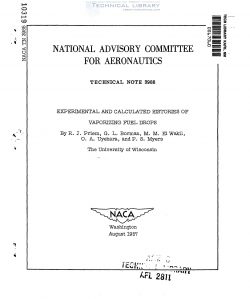naca-tn-3988
- Version
- 108 Downloads
- 2.40 MB File Size
- 1 File Count
- January 29, 2017 Create Date
- January 29, 2017 Last Updated
National Advisory Committee for Aeronautics, Technical Notes - Experimental and Calculated Histories of Vaporizing Fuel Drops

Fuel which is injected into a combustion chamber by a nozzle leaves
the nozzle orifice as sheets or ligaments which eventually break down
into drops of varying sizes. As soon as these drops are formed they
start to vaporize because of the increase of surface-to-volume ratio.
As the drop vaporizes it simultaneously heats 1m until its temperature
approaches asymptotically a constant temperature which is determined by
the environmental conditions. Previous investigations of fuel ignition
are discussed in references 1 to 16.
A detailed theoretical study of the unsteady-state portion of the
total vaporization time for single droplets was performed in a previous
investigation (ref. 1). From this study it was estimated that the larger
drops emanating from the injector of a Jet engine reach the combustion
zone while still in the unsteady-state or heating-up period. After the
importance of the unsteady state had been verified theoretically a
combined theoretical and experimental investigation was undertaken to
determine if the unsteady-state period was important (ref. 2). This
combined investigation served to check the accuracy of the theoretical
calculations.
The combined theoretical and experimental investigation showed that
the theory used for the calculations produced histories which gave
reasonable agreement with the experimental histories. The range of
conditions covered by this first experimental investigation was limited
to drop sizes in the neighborhood of 2,000-m1cron initial diameter and
to a maximum air temperature of 1,0800 B. In order to bring the experi-
mental conditions closer to actual jet conditions the investigation was
extended to smaller drop sizes, higher air temperatures, and different
fuels. The results of this extended investigation are reported herein.
In addition to the extension of the range of conditions covered
experimentally, comparisons were made with calculated histories to
determine and to illustrate the agreement between theoretical and exper-
imental results. By plotting the comparisons against various parameters
the trends of the theoretical accuracy are determined, thereby indicating
the error that would be obtained by extrapolating the theoretical tech-
nique to conditions other than those covered in this investigation.
| File | Action |
|---|---|
| naca-tn-3988 Experimental and Calculated Histories of Vaporizing Fuel Drops.pdf | Download |
Comment On This Post